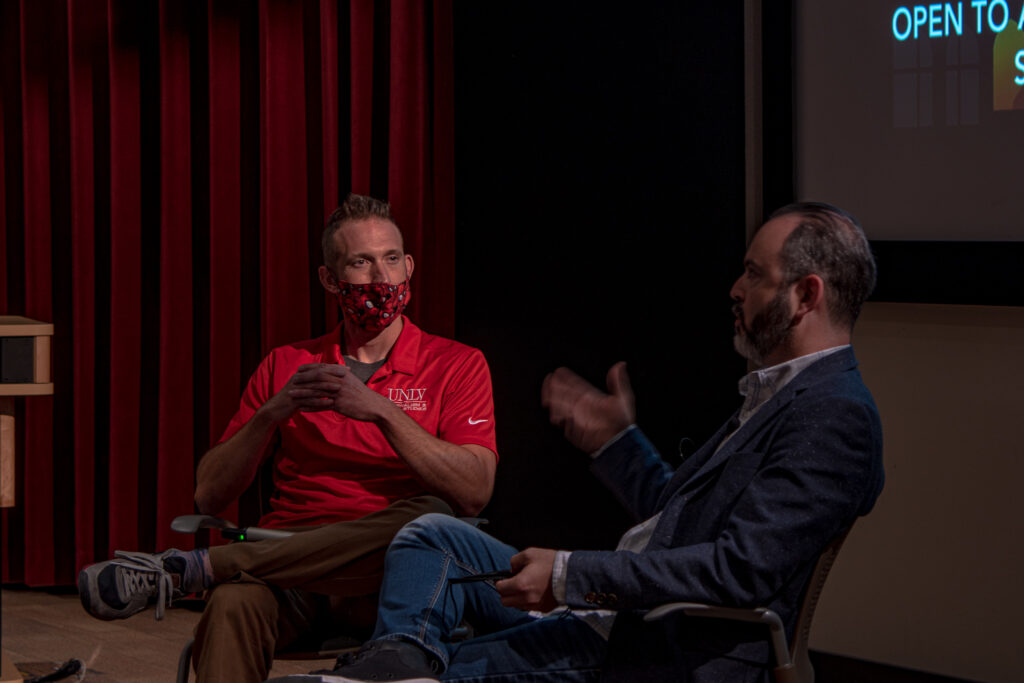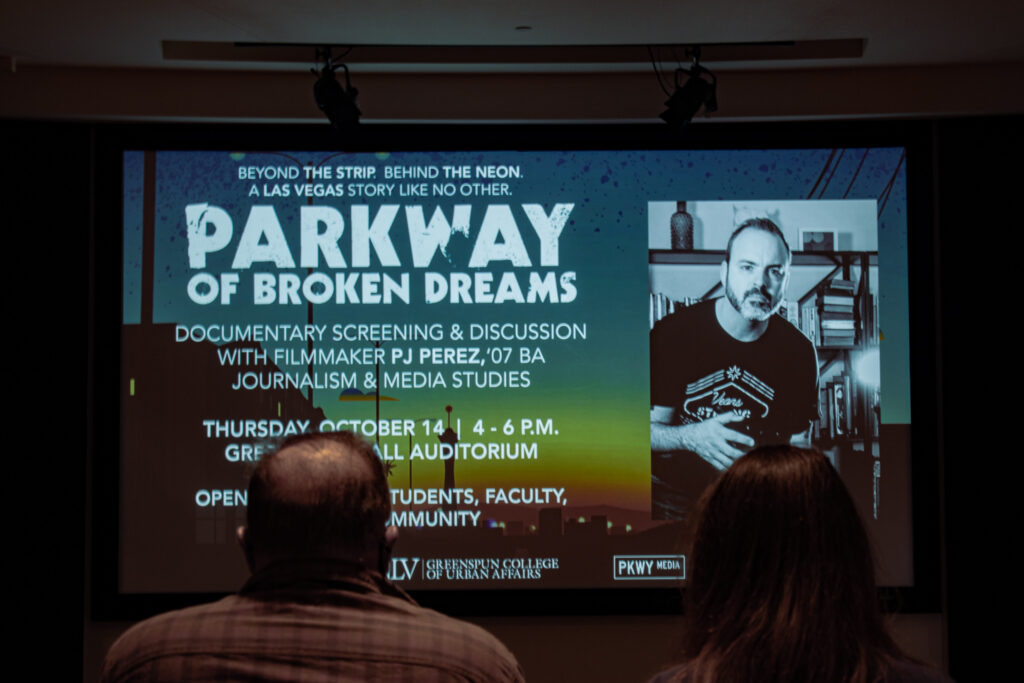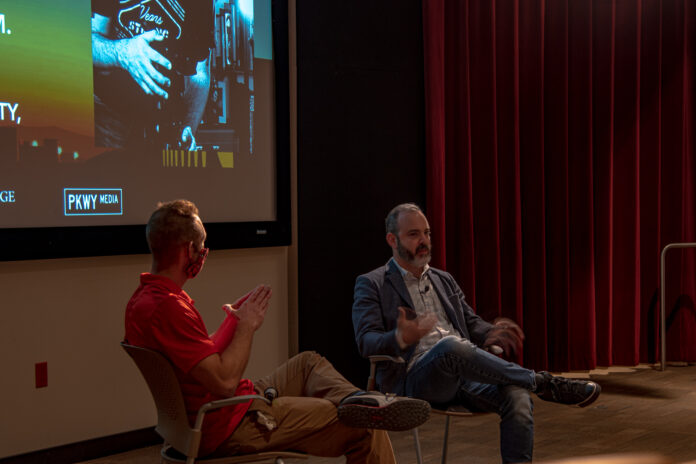PJ Perez’s new documentary on the arts and entertainment scene of Maryland Parkway in the 1990s started as a feature writing assignment at UNLV.
Perez pitched his 2,500 word story to the Las Vegas Weekly, where he was freelancing at the time, and it became an oral history, chosen as the cover story for the magazine. That project received great feedback and became the basis for Perez’s “Parkway of Broken Dreams” documentary that premiered last week.
Maryland Parkway was the site of Las Vegas’s first cultural environment, which appeared in the late 1980s and early 2000s. Perez was a regular at the various coffee shops, record stores, music venues and other events taking place across the street from UNLV.
“[The Las Vegas cultural scene] was very spotty until things sort of started happening all in one area, which was spurred by The Newsroom (a coffee shop) moving from Downtown to the promenade center right across from UNLV in 1987,” Perez said. “That really kicked off the slow, organic growth of things happening around the university.”
Students migrated over from UNLV and began spending more time at The Newsroom and other businesses around the area that embodied the alternative culture scene that was sprouting on Maryland Parkway.
Maryland Parkway proved to Las Vegas residents that they did not have to leave the city to find an arts and culture scene. Las Vegas was still a relatively small town and growth on the Strip was stunted through the ‘70s and ‘80s, but the new cultural scene helped locals find a better connection with their city.
“When all these things were happening at the same time on Maryland Parkway, I think it was a way to kind of alleviate more of the cultural life without having to leave Vegas, which then changed your perception of living in Vegas,” Perez said.
“A Less Sanitized Central Perk”
Everyone in the ‘90s were hanging out in coffee shops, and they were popping up in multitudes across college campuses. UNLV saw its own coffee house bomb with many others springing up along Maryland Parkway.
“You watch every episode of ‘Friends’ and 50 percent of the episodes take place in a coffee shop,” Perez said. “They’re just hanging out on this couch for who knows how long like it’s their living room. That is basically what coffee shop culture was like in the ‘90s.”
Students and others partaking in the scene would hang out on the used furniture and other spots, set up shop for a couple hours and interact with the people around you. In the time before the internet, coffee shops became the place where everyone, especially the under-21 crowd, would interact.
Places like Cafe Espresso Roma, Cafe Copioh or Cafe Rainbow, were the setting for everyone to get together and enjoy the culture. Many bands, poets, artists and other performers had a venue to express themselves.

Even if there was not an event taking place that night, being there became an event. It was where everyone would be for hours into the night and where the ideas for the scene would emerge.
“You would have the idea for the creative event you want to put on at the place that you’re going to put it on,” Perez said. “That was enabled by the fact that you were all just hanging out in the same place at the same time.”
More Than A Radio Station
UNLV’s college radio station, KUNV, perfectly served as the soundtrack to what was happening across the street from campus.
At 8 p.m. every night, UNLV students took over the station with the award-winning “Rock Avenue” show that played a wide variety of music you couldn’t find anywhere else in Las Vegas.
“I talked to a lot of people for this film and they all had the same experience of KUNV being not just a college radio station, but really an entity unto itself,” Perez said. “It was the place where you heard new music that wasn’t being played anywhere else and it was the place that connected you to the places to get that music.”
From new wave to punk to alternative, KUNV played everything. It was where many local artists playing at venues across Maryland Parkway and Las Vegas had their music played.
There was also a “symbiotic relationship” between KUNV, the record stores and venues. Ron Benway, who co-owned the Benway Bop Record Shop, had a show where he would promote local artists’ music and shows at his store.
For many, the cycle of finding new music would start by hearing a new band on KUNV, stopping at Underground Records or Benway Bop to buy that band’s album, and then going to the Huntridge or the local coffee shop to hear that band.
“It was a very open, atypical experience, even for a college radio station because it was a place that you could hang out since it was in the Student Union,” Perez said. “It became part of the community physically as much as it was sonically.”
Broken Dreams
Las Vegas locals at the time were used to things coming and going, and eventually, the scene on Maryland Parkway began to die down and move to downtown Las Vegas.
“You kind of started to see the cracks,” Perez said. “It was really clear when certain things happen, like when you know a record store closed we’re like, ‘If this record store couldn’t make it. How much longer does this other one have?’”
Under new management, KUNV canceled “Rock Avenue” and changed its format completely. That was the beginning of the change on Maryland Parkway as the music from the scene lost its outlet.

The Enigma Cafe opening downtown marked the beginning of the cultural scene’s shift to the area that is now the Las Vegas Arts District. More art galleries started opening up downtown, and the bigger, permanent spaces drew artists there. That attracted the people who had been hanging out on Maryland Parkway.
“It wasn’t that anyone thought it was gonna last forever. It was that you hoped it would last forever,” Perez said. “You had a dream that this scene could be bigger than what it is.”
The Las Vegas arts scene flourished Downtown, leaving a vacancy on Maryland Parkway. Those who were involved in the scene, but left town and came back to visit, saw that many of the buildings they spent a lot of their lives in were gone.
“Those dreams that those people had that of [Maryland Parkway] being this amazing thing were shattered,” Perez said.
Long Standing Connections
While Maryland Parkway has lost its standing as a cultural hotbed, the memories and friendships created in that time will never go away. The scene may have moved to the Arts District, where Perez says it belongs now, but Maryland Parkway will not be replicated again.
“The thing that I miss about that place in that period is the idea that you can just show up, without the people, and you find your people,” Perez said.
Since it was the age before the explosion of the internet and pre-social media, there was a “show up and see what happens” type of energy. You could show up to a coffee shop and make friends with someone you never met before because you were there to see the same band.
While everyone might have known everyone, they were all a part of the same scene. Even if two people didn’t interact back then, they could quickly pick up a conversation of what Maryland Parkway was like because they both were there at the same time.
“We all had the same experience even if we were experiencing different facets of it at the same time, so there’s this interconnectivity between these people who’ve never even met,” Perez said. “What made this thing special for so many people is that there was this interconnectivity that we had, without even realizing it.”

